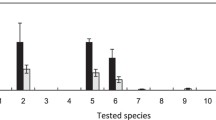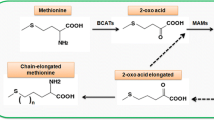Abstract
Over 90% of the cyanogenic precursors ofHevea seeds is stored in the endosperm tissue. During seedling development most of the cyanogenic material is consumed to form noncyanogenic compounds. No gaseous HCN is liberated in the course of this process. The β-glucosidase, responsible for the cleavage of cyanogenic glucosides and the key enzyme for cyanogenesis is widely distributed over all tissues. The highest enzyme activity of the HCN-metabolizing β-cyanoalaninesynthase is found in young seedling tissues. It is concluded, that the cyanogenic glucosides must be transported and metabolized in the young, growing tissues.
Similar content being viewed by others
References
Akazawa, T., Milvanich, P., Conn, E. E., 1960: Studies on cyanogenic glucoside ofSorghum vulgare. — Pl. Physiol.35, 535–538.
Baker, N. R., Hardwick, K., 1973: Biochemical and physical aspects of leaf development in cocoa (Theobroma cacao). — New Phytologist72, 1315–1324.
Blain, H., 1975: Zmiany w zawartosci zwiazkow cyanogennych w ontogenezie komonicy rozkowej (Lotus corniculatus L.). — Pamietnik Pulawski62, 131–139.
Blumenthal-Goldschmidt, S., Butler, G. W., Conn, E. E., 1963: Incorporation of hydrocyanic acid labelled with Carbon 14 into asparagine in seedlings. — Nature197, 718–719.
Bough, W. A., Gander, J. E., 1971: Exogenius L-tyrosine metabolism and dhurrin turnover inSorghum seedlings. — Phytochemistry10, 67–77.
Bradford, M., 1976: A rapid and sensitive method for the quantitation of microgram quantities of protein utilizing the principle of protein dye binding. — Anal. Biochem.72, 248–254.
Butler, G. W., 1965: The distribution of the cyanoglucosides linamarin and lotaustralin in higher plants. — Phytochemistry4, 127–131.
Celestino Filho, P., Conceição, H. E. O., 1981: Ataque daErinnyis ello em plantios de seringueira. — Elastomeros (Sao Paulo)7 (1–3), 12–13.
Chew, M.-Y., 1973: Rhodanese in higher plants. — Phytochemistry12, 2365–2367.
Clegg, D. O., Conn, E. E., Janzen, D. H., 1979: Developmental fate of the cyanogenic glucoside linamarin in Costa Rica wild lima bean seeds. — Nature278, 343–344.
Dijkman, M. J., 1951:Hevea-Thirty years of research in the far east. — Coral Gables, Florida: University of Miami Press.
Floss, H. G., Hadwiger, L., Conn, E. E., 1965: Enzymatic formation of β-cyanoalanin from cyanide. — Nature208, 1207–1208.
Gander, J. E., 1960: Factors influencing in vivo formation of phydroxymandelonitrile-β-D-glucoside. — Pl. Physiol.35, 767–771.
Godwin, H., Bishop, L. R., 1927: The behaviour of the cyanogenetic glucosides of cherry laurel during starvation. — New Phytol.26, 295–315.
Hallé, F., Martin, R., 1968: Etude de la croissance rhythmique chez l'Hevea. — Adansonia ser. 2,8, 475–503.
Hösel, W., Nahrstedt, A., 1975: Spezifische Glucosidasen für das Cyanglucosid Triglochinin-Reinigung und Charakterisierung von β-Glucosidasen ausAlocasia macrorrhizza Schott. — Hoppe-Seylers Z. Physiol. Chem.356, 1265–1275.
Lieberei, R., 1981: Resistenzbedingende Faktoren vonHevea brasiliensis gegenMicrocyclus ulei, den Erreger der südamerikanischen Blattkrankheit des Parakautschukbaumes. — Mitteilungen aus der Biologischen Bundesanstalt für Land- und Forstwirtschaft203, 217.
— 1984: Cyanogenese und Resistenz-physiologische Studien zur Wirt-Pathogen-Beziehung bei cyanogenen Pflanzen, durchgeführt am Wirt-Pathogen-SystemHevea brasiliensis —Microcyclus ulei. — Habilitationsschrift zur Vorlage an der Naturwissenschaftlichen Fakultät der TU Braunschweig, 265 Seiten.
— 1985: Cyanogenesis ofHevea brasiliensis during infection withMicrocyclus ulei. — Submitted to Phytopathologische Zeitschrift.
—, 1984: Hemmung von Resistenzmechanismen durch Blausäure in cyanogenen Pflanzen. — Mitteilungsband der Botaniker-Tagung Wien, p. 165. — Wien: Institut für Botanik der Universität Wien.
Lowry, O. H., Rosebrough, N. J., Farr, A. L., Randall, R. J., 1951: Protein measurement with the Folin-phenol-reagent. — J. Biol. Chem.193, 265–275.
Lloyd, R. C., Gray, E., 1970: Amount and distribution of hydrocyanic acid potential during the life cycle of plants of three sorghum cultivars. — Agron. J.62, 394–397.
Miller, J., Conn, E. E., 1980: Metabolism of hydrogen cyanide by higher plants. — Pl. Physiol.65, 1199–1202.
Nartey, F., 1968: Studies on cassava,Manihot utilissima Pohl, I. cyanogenesis: The biosynthesis of linamarin and lotaustralin in etiolated seedlings. — Phytochemistry4, 297–303.
Robinson, M. E., 1929: reference inRobinson (1930).
—, 1930: Cyanogenesis in Plants. — Biochemical Reviews of the Cambridge Philosophical Society5, 126–141.
Selmar, D., Lieberei, R., Biehl, B., 1982: β-Glucosidase der cyanogenen PflanzeHevea brasiliensis. — Jubiläumstagung der Deutschen Botanischen Gesellschaft, Kurzfassung der Vorträge und Poster, Posterpaket 2, 018.
Sörbo, B. H., 1951: Cristallisation of bovine liver rhodanese. — Acta Chem. Scand.5, 724–734.
Stafford, H. A., 1969: Changes in phenolic compounds and related enzymes in young plants ofSorghum. — Phytochemistry8, 743–752.
Treub, M., 1896: Ann. Jard. Bot. Buitenzorg.13, 1. (Reference inRobinson 1930).
—, 1907: Ann. Jard. Bot. Buitenzorg.21 (2), 79. (Reference inRobinson 1930).
Westley, J., 1959: A comparison of some biochemical properties of the beef liver and beef kidney rhodanese. — J. Biol. Chem.234, 1857–1860.
Zandee, M., 1976: Beobachtungen über Cyanogenese in der GattungJuncus. — Proc. Koninklijke Ned. Akad. van Wetenschapen79, 529.
Author information
Authors and Affiliations
Additional information
Lecture held at the Tagung der Deutschen Botanischen Gesellschaft in Vienna, September 1984.
Rights and permissions
About this article
Cite this article
Lieberei, R., Selmar, D. & Biehl, B. Metabolization of cyanogenic glucosides inHevea brasiliensis . Pl Syst Evol 150, 49–63 (1985). https://doi.org/10.1007/BF00985567
Issue Date:
DOI: https://doi.org/10.1007/BF00985567




